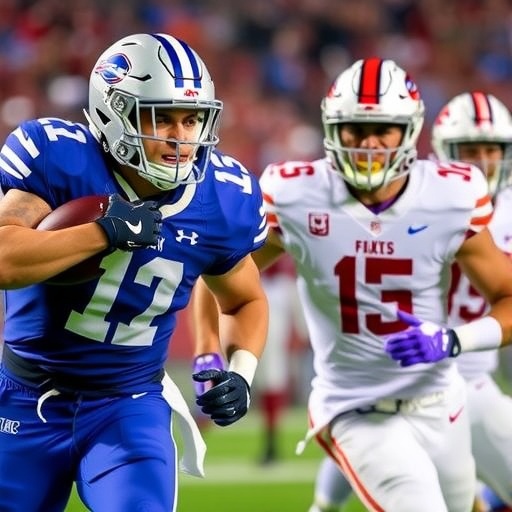SEC Recruiting Dominance Under Scrutiny: Unexpected Contenders Disrupt College Football Preseason Chaos
In a stunning twist to the 2023 college football season, the Southeastern Conference (SEC), long hailed as the recruiting powerhouse of the sport, is facing unprecedented backlash as its star-studded classes fail to translate into on-field success. While preseason polls painted a picture of SEC supremacy with teams like Alabama and Georgia boasting the nation’s top recruiting hauls, early-season chaos has exposed vulnerabilities, allowing unexpected contenders from lesser conferences to steal the spotlight and challenge the established order.
This upheaval comes at a critical juncture, just weeks into the season, as upsets and inconsistent performances from SEC powerhouses have fans and analysts questioning whether the conference’s heavy investment in high school talent is yielding diminishing returns. With recruiting cycles becoming more volatile due to the transfer portal and NIL deals, the SEC’s traditional edge is under the microscope like never before.
SEC’s Elite Recruits Stumble in High-Stakes Openers
The SEC entered the 2023 season with unparalleled recruiting firepower. According to 247Sports Composite rankings, five of the top 10 recruiting classes belonged to SEC schools: Georgia (No. 1), Alabama (No. 2), Texas A&M (No. 4), LSU (No. 5), and Auburn (No. 7). These classes were loaded with five-star prospects, including quarterbacks, edge rushers, and wide receivers projected to dominate immediately.
Yet, reality has been far kinder to underdogs. Alabama, fresh off a national championship appearance, suffered a shocking 27-24 loss to Texas in Week 2, despite featuring recruits like five-star edge rusher Jeremiah Alexander and cornerback Domani Jackson. Coach Nick Saban, in a post-game press conference, admitted the growing pains: “We’ve got talent, but talent alone doesn’t win games. Execution is everything, and we’re still building that.”
Georgia, the defending champions, barely escaped a scare against South Carolina, winning 24-14 after trailing at halftime. Their vaunted recruiting class, headlined by quarterback Dylan Raiola (who flipped his commitment but left a void), struggled with turnovers from freshman running back Trevor Etienne. Statistics from the first three weeks show SEC teams averaging just 28.4 points per game—down from 32.1 last season—highlighting integration issues with new recruits.
Experts point to the transfer portal’s role in diluting pure recruiting impact. “The SEC spends millions on 17-year-olds, but veterans from other conferences are plugging holes faster,” says ESPN analyst Kirk Herbstreit. This mismatch has led to a 4-3 record against non-SEC opponents in non-conference play, a far cry from the expected blowouts.
Unexpected Contenders Emerge from the Shadows
While the SEC grapples with its recruiting conundrums, a cadre of unexpected contenders is rewriting the college football narrative. Teams from the Big 12, ACC, and even Group of 5 conferences have capitalized on the chaos, posting upset victories that preseason prognosticators never saw coming.
Take Washington, an ACC newcomer via the Pac-12 dissolution, now 3-0 after dismantling Tulsa 56-19. Their recruiting class ranked a modest 22nd, but quarterback Michael Penix Jr.’s leadership has elevated a roster blending transfers and overlooked gems. Similarly, Kansas State shocked the nation with a 38-9 rout of Missouri, an SEC foe, leveraging a balanced attack from recruits like running back DJ Giddens, a three-star who has rushed for 285 yards already.
In the Group of 5, James Madison University stands out as a true Cinderella story. Undefeated at 4-0, the Dukes toppled North Carolina 70-61 in a thriller, thanks to a recruiting class ranked 68th that emphasizes speed and scheme fit over star power. Coach Curt Cignetti noted, “We don’t chase five-stars; we build programs that develop three-stars into All-Americans.”
Statistics underscore the shift: Non-power conference teams are 12-5 against Power 5 opponents this season, per NCAA data, compared to 8-12 last year. These unexpected contenders are thriving on cohesion and strategic recruiting, often targeting regional talent ignored by SEC behemoths. The transfer portal has been a boon here too, with schools like Fresno State adding proven players without the hype of massive signing classes.
- Key Upsets: Texas over Alabama (Week 2)
- James Madison over North Carolina (Week 3)
- Kansas over Nevada (Week 1, foreshadowing Big 12 strength)
This surge isn’t just luck; it’s a symptom of broader changes in college football, where NIL collectives allow mid-tier programs to compete financially, poaching talent that once flowed solely to the SEC.
Preseason Expectations Crumble Under Early-Season Pressure
Preseason hype for the SEC was deafening. Athlon Sports and USA Today polls had seven SEC teams in the top 10, with Alabama and Georgia as co-favorites for the national title. Recruiting was the cornerstone: The conference signed 312 high school players in the 2023 cycle, more than any other, per On3 Industry rankings.
But the first month has been a rude awakening. LSU, with a top-5 class including quarterback Garrett Nussmeier, limped to a 1-2 start after losses to Florida State and Mississippi State. Texas A&M, spending over $10 million on NIL for recruits like Walter Nolen, sits at 2-1 but underwhelmed in a 28-23 win over Miami.
“Preseason rankings are based on paper tigers,” quips CBS Sports’ Barrett Sallee. “The SEC’s recruiting dominance assumes seamless transitions, but with new rules on roster limits and eligibility, it’s chaos.” Indeed, injuries to key recruits—like Auburn’s five-star quarterback Payton Thorne sidelined with a hamstring issue—have exacerbated the faltering expectations.
Broader context reveals a league divided: While the SEC’s East division looks vulnerable, the West remains gritty, but overall, the conference’s 15-5 record masks close calls and reliance on schedule strength. Fan frustration is palpable, with #SECOverrated trending on social media after Week 3, amassing over 50,000 posts.
- Week 1 Highlights: SEC teams averaged 35 points, but against weak non-conference foes.
- Week 2 Reality Check: Three losses to Big 12 teams alone.
- Week 3 Fallout: Only 60% of SEC games decided by more than one score.
This preseason disillusionment has ripple effects, from booster donations to coaching pressures, forcing the SEC to confront whether its recruiting model needs evolution in the NIL era.
Analysts Debate the Future of SEC Recruiting Supremacy
As scrutiny intensifies, college football insiders are dissecting the SEC’s recruiting woes with a mix of concern and opportunity. Paul Finebaum, SEC Network’s outspoken voice, warns, “If the SEC doesn’t adapt, we’ll see more of these unexpected contenders chipping away at our throne.” He points to data from the past five years: SEC teams have won four national titles, but their win percentage against non-SEC foes has dipped to 78% from 85% pre-2020.
Recruiting gurus like Allen Trieu of 247Sports argue that the portal is the great equalizer. “SEC schools still get the blue-chippers, but retention is key. We’ve seen 25% of top-100 recruits transfer within two years,” Trieu says. Case in point: Ohio State’s Class of 2022 lost three five-stars to the portal, yet the Buckeyes are thriving at 3-0 without SEC-level spending.
From a business angle, the SEC’s dominance funds massive TV deals—$3 billion annually via the SEC Network—but faltering performance risks alienating viewers. A survey by The Athletic found 62% of fans believe non-SEC conferences will produce a playoff team this year, up from 45% preseason.
Emerging trends include hybrid recruiting: Schools like Clemson (ACC, but SEC-adjacent) are blending high school signees with grad transfers, achieving a 90% roster stability rate. For the SEC, this means rethinking scout evaluations to prioritize fit over flash.
Quotes from recruits themselves add color. Five-star Georgia signee Ellis Robinson IV told Sports Illustrated, “The pressure is real, but we’re learning fast. Wins will come.” Yet, whispers of decommitments loom for 2024, with prospects eyeing stable programs amid the chaos.
Playoff Implications and Recruiting Reset for the SEC
Looking ahead, the SEC’s recruiting scrutiny could reshape the College Football Playoff landscape. With the expanded 12-team format debuting in 2024, unexpected contenders like a surging Oregon (4-0, No. 6 recruiting class) or undefeated Liberty (top-25 G5) are positioning for at-large bids, potentially squeezing out one or two SEC teams.
Projections from the College Football Playoff Committee already show volatility: As of Week 3, only three SEC teams rank in the top 12, compared to seven preseason. If trends continue, the conference risks its first sub-five playoff representatives since 2015.
For recruiting, the reset is underway. Conferences like the Big Ten are ramping up NIL war chests, with Michigan’s collective surpassing $15 million. SEC commissioner Greg Sankey addressed this in a recent statement: “We’re committed to excellence, but evolution is necessary. Expect more targeted investments in development pipelines.”
By midseason, watch for adjustments: More redshirt decisions for freshmen, aggressive portal activity in December, and a focus on regional recruiting to counter unexpected contenders. The 2024 cycle, opening soon, will test whether the SEC can reclaim its throne or if college football’s power structure is truly fracturing. One thing’s certain—the chaos has only just begun, promising a thrilling path to the postseason.








